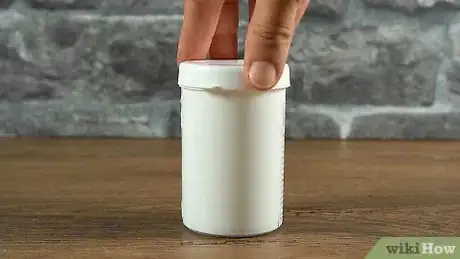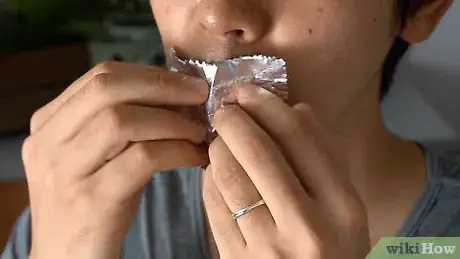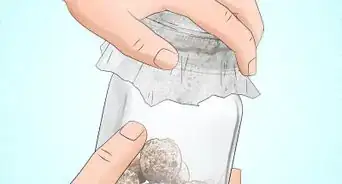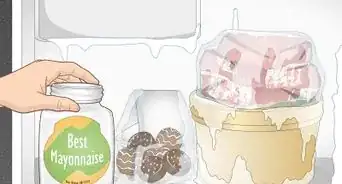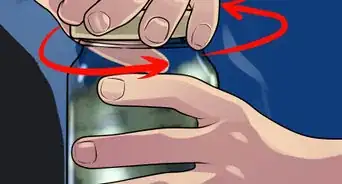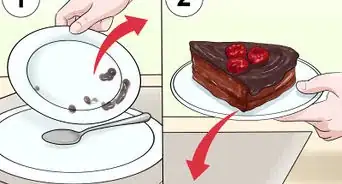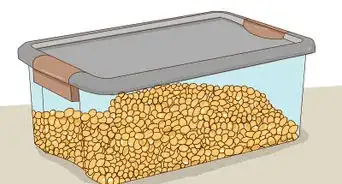This article was co-authored by wikiHow staff writer, Christopher M. Osborne, PhD. Christopher Osborne has been a wikiHow Content Creator since 2015. He is also a historian who holds a PhD from The University of Notre Dame and has taught at universities in and around Pittsburgh, PA. His scholarly publications and presentations focus on his research interests in early American history, but Chris also enjoys the challenges and rewards of writing wikiHow articles on a wide range of subjects.
There are 9 references cited in this article, which can be found at the bottom of the page.
The wikiHow Culinary Team also followed the article's instructions and verified that they work.
This article has been viewed 27,355 times.
Learn more...
Buying chewing gum in bulk can save you money, but only if you store it properly so it remains chewy and flavorful. Fortunately, packaged chewing gum stays fresh for several months, if not longer, when kept in a cool, dry, dark place. However, if you happened to invest in some "chewing gum art" (or made some of your own), be warned that it's really difficult to permanently preserve used chewing gum![1]
Steps
Storing Gum at Home
-
1Keep the gum in its original packaging. Gum is packaged to maintain freshness, so it makes sense to keep it that way until you’re ready to chew it. If your gum package is sealed in a plastic overwrap, keep the overwrap in place until it’s time to grab a piece of gum from the package.[2]
- Gum comes packaged many different ways, from plastic bags to metal tins to paper cartons, to name just a few. However your favorite gum is packaged, leave it as-is as much as possible.
-
2Seal your gum packages in one or more airtight containers. If the gum package is already sealed up in a plastic overwrap, this step is probably overkill. However, if you’ve already opened the gum package, storing it in a jar or other airtight container can help keep your gum fresh and flavorful.[3]
- Keeping different flavors of gum in the same sealed container may cause the flavors to mingle in unpleasant ways. If you like both cinnamon and spearmint gum, for instance, you should probably store them separately!
Advertisement -
3Stick the gum in a cool, dry, dark place. Most types of gum start to soften at around 80 °F (27 °C), and get really soft in environments above about 95 °F (35 °C)—like in your mouth! For the best results, aim for these storage conditions: a temperature between about 50–75 °F (10–24 °C); average indoor humidity (around 50%); and cover from direct sunlight.[4]
- A pantry cupboard or coat closet can make a good storage spot for gum. Bad storage choices include a jar on the windowsill or a kitchen cupboard right up against the oven.
-
4Don’t store gum in the fridge or freezer. “Cool” is good for gum storage, but “cold” may cause more harm than good. Gum that has been stored in a refrigerator or especially a freezer usually becomes brittle and difficult to chew. Gums that are encased in hard shells may fare a bit better than stick gums, but room temperature storage is usually superior in all cases.
- Your freezer is, however, very useful in helping to remove gum from fabrics!
-
5Chew the gum within 8-10 months for the best flavor and texture. The sooner you open a pack of gum, the softer, chewier, and more flavorful it will be. That said, even a gum connoisseur is unlikely to notice much difference between a newly-bought stick of gum and one that’s been properly stored for 6 months! In general, you won’t notice any difference in quality for at least 8-10 months after purchase.[5]
-
6Throw out the gum if it looks or smells bad. You’re unlikely to come across moldy or rotten chewing gum, but it’s possible in some cases. Trust your senses before putting any questionable piece of gum in your mouth. If you see splotches or discolorations, or smell any off odors, toss the entire package of gum in the trash.[6]
- If the gum looks and smells okay but has an off taste once you put it in your mouth, spit it out and get rid of the whole pack.
- It’s much more likely that the gum in an old package will become dry, brittle, and unpleasant to chew. While you can try to soften it up with some assertive chewing, buying new gum is probably your best bet.
-
7Don't toss out gum just because it's past its "best by" date. Remember that chewing gum rarely “goes bad” in the sense that it might cause you harm. Generally, its quality just goes downhill over time. The “best by” date is only an estimate by the manufacturer about when this decline in quality will happen. If the gum still looks and tastes fine, go ahead and chew it![7]
- Some gums may be perfectly fine for months after the “best by” date, while others may decline in quality shortly afterward. But, even as the quality fades, it’s extremely unlikely that the gum will become a possible source of foodborne illness.
-
8Store nicotine gum according to its specific instructions. The storage instructions for chewing gum and prescription medications are similar in several respects—it’s usually best to store them in a cool, dry, dark place. Not surprisingly, then, this is the general storage advice for medicated nicotine gums used for smoking cessation. Always follow the specific storage instructions on the package, though.[8]
- The package may give you a maximum temperature—for example, 77 °F (25 °C)—at which to store the gum.
- Storing the gum improperly may impact the potency and effectiveness of the medication.
Carrying Gum with You
-
1Keep your gum in a purse or bag instead of your pocket. While it’s convenient to stash a pack of gum in your pants pocket, your body heat may cause the gum to become overly soft, sticky, and deformed. In some cases, the softened gum may ooze out of the packaging and get stuck to the inside of your pocket.[9]
- A shirt pocket is a slightly better choice than a pants pocket, but it’s still possible that your body heat may make the gum soft and sticky.
- Generally speaking, try to keep packaged gum at or below 80 °F (27 °C).
-
2Store gum in a shady spot in your vehicle during hot weather. A sunny location in your vehicle can easily reach 130 °F (54 °C) or higher on a summer day, which is plenty hot enough to turn your gum into sticky goo! Keeping your gum in a shady location, like the glove box or center console, is more likely to keep it under about 90 °F (32 °C).[10]
- Alternatively, during the winter, the temperature inside your car may fall below 32 °F (0 °C) and cause your packaged gum to turn brittle and unpleasant to chew. So you may just want to keep your gum package with you instead of leaving it in the car!
-
3Save the gum wrapper for disposal or short-term storage. If you need to remove a piece of gum from your mouth, the most sanitary option is to spit it out into its wrapper, wrap it up, and throw it in the trash. If you really want to put the gum back into your mouth after you take a drink or make a phone call, it will probably stay soft in the wrapper for a good 5 minutes. But why not just chew a new piece of gum instead?
- Don’t stick your used gum on the wall, under a desk, or anywhere else but the trash—that’s unsanitary and just plain gross! And, assuming that you don’t like stepping in gum yourself, don’t throw your own used gum on the ground.
-
4See if “gum recycling” is available in your area. Some cities have run trials that involve setting up “gum recycling” boxes for used chewing gum. If this is happening where you live, go ahead and put your unwrapped used gum in the marked box instead of in the trash.[11]
- Don’t worry—“recycling” doesn’t mean that your old chewing gum is turned into new chewing gum! Instead, the used gum and the recycling box are turned into a plastic product that can be molded to shape for various uses.
Warnings
- Store your chewing gum out of the reach of small children. Generally speaking, children under 4 years of age should not chew gum, and kids over 4 need to know how to properly chew and dispose of gum (instead of swallowing it).[16]⧼thumbs_response⧽
References
- ↑ https://www.theatlantic.com/science/archive/2017/06/how-do-you-conserve-art-made-of-bologna-or-bubble-gum-or-soap/529713/
- ↑ https://www.stilltasty.com/fooditems/index/16773
- ↑ https://www.stilltasty.com/fooditems/index/16773
- ↑ https://www.theatlantic.com/science/archive/2017/06/how-do-you-conserve-art-made-of-bologna-or-bubble-gum-or-soap/529713/
- ↑ https://www.stilltasty.com/fooditems/index/16773
- ↑ https://www.stilltasty.com/fooditems/index/16773
- ↑ https://www.stilltasty.com/fooditems/index/16773
- ↑ https://www.drugs.com/uk/nicotine-mint-4-mg-medicated-chewing-gum-leaflet.html
- ↑ https://www.theatlantic.com/science/archive/2017/06/how-do-you-conserve-art-made-of-bologna-or-bubble-gum-or-soap/529713/
- ↑ https://www.theatlantic.com/science/archive/2017/06/how-do-you-conserve-art-made-of-bologna-or-bubble-gum-or-soap/529713/
- ↑ https://www.cnbc.com/2015/12/01/recycle-used-chewing-gum-waste-keep-streets-clean.html
- ↑ https://www.jneb.org/article/S1499-4046(14)00437-0/fulltext
- ↑ https://www.sciencedaily.com/releases/2013/03/130308093933.htm
- ↑ https://www.ada.org/en/member-center/oral-health-topics/chewing-gum
- ↑ https://selecthealth.org/blog/2017/04/surprising-benefits-of-chewing-gum
- ↑ https://www.aap.org/en-us/about-the-aap/aap-press-room/aap-press-room-media-center/Pages/Chewing-Gum.aspx


